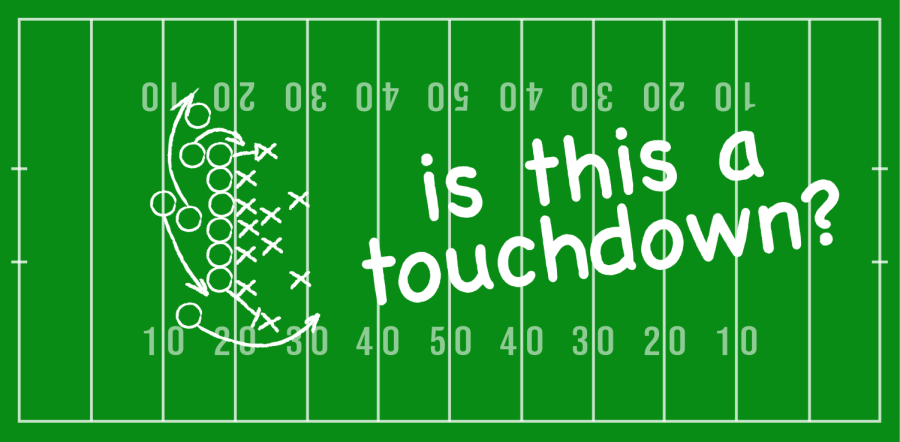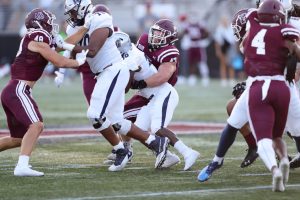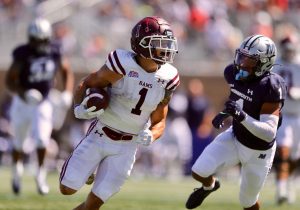What’s the Deal With Football?
An introductory guide for Lincoln Center students eager to learn and understand American football
September 17, 2022
Football is a staple of American culture. It’s typically defined as an event where friends and family gather outside of a large stadium, bars or each other’s homes, eating nacho cheese and fast food. Sundays commonly feature professional games, and Saturdays are reserved for college games. College football games are an event that many students look forward to as a part of their undergraduate experience. Sitting in the stands wearing your university’s colors and rooting for their team is an experience like no other.
Fordham football fans flock to Jack Coffey Field, which sits at Fordham’s Rose Hill campus, slightly over 9 miles away from Lincoln Center (LC). Although LC students do find themselves occasionally sitting in the stadium seats, it is not a common occurrence. Showing up to football games is more commonly associated with Rose Hill student life.
Football is a fascinating part of American culture, offering a sense of community and allowing people to come to celebrate the success of a preferred team. Having an understanding of the sport can make it a more enjoyable experience for LC students who want to see the Rams perform at one of their five home games this season.
Kristjan Sokoli, former NFL defensive and offensive line player for the Seattle Seahawks, Indianapolis Colts and New York Giants, gave The Observer a guide to football for those seeking to better understand the sport.
The Start of Football
Football’s formal name is “gridiron football,” since the sport is distinguished by the vertical lines painted onto the field. The “Father of American Football” in 1876 was a Yale undergraduate and medical student named Walter Camp.
Football is a mixture of rugby and soccer. Over time, Camp played a role in turning this new sport into American football by developing the rules in the Intercollegiate Football Association (IFA).
Sokoli explained that the linemen’s main focus is to protect the quarterback or any other player who is holding the ball.
One thing Camp influenced in the IFA was the change from beginning the game with a “scrummage” and instead establishing a system of “downs.”
Camp also developed the way football is scored, established 11 players per team, and created the position of quarterback and the line of scrimmage.
Positions
Football, like many sports, is broken up into offensive and defensive positions. When one team’s offensive players are in possession of the ball, then the other team’s defensive players are out trying to stop the offensive players from scoring any points. There are also special team players. While there is an extensive list of over 20 positions, here are some of the more notable ones.
The defensive positions include defensive linemen and defensive backs.
The offensive positions include a quarterback, running backs, wide receivers, tight ends and offensive linemen.
You may be wondering, “Which of these positions should I be paying attention to?”
Sokoli offered a breakdown of key players during a game. “I think it all starts with the guys up front: … It all starts with the linemen.”
Sokoli explained that the linemen’s main focus is to protect the quarterback or any other player who is holding the ball. Sokoli continued, “The beauty of football, every position is important. And in different situations, some positions are more important than others.”
For example, in a situation where one player is attempting to move the ball toward the end of the field, referred to as the end zone, the wide receivers become the “most important” on the field.
There are offensive and defensive linemen. The offensive line contains five players: center, left and right guard, as well as left and right tackle. The offensive linemen are typically the most physical players on the team, as they must create openings by pushing defensive players and allowing whoever is holding the ball to run past the other team’s defense.
Terms to Know
Running the ball: Sokoli defines “running the ball” as “when the quarterback hands the ball to the running back, who’s directly behind him.” Quarterbacks can also run the ball, but it can put them at risk of injury or a turnover. This is related to specialization, and quarterbacks do not train to take hits and tackles on a regular basis. The excessive impact can ruin a quarterback’s primary asset: his throwing arm.
Line of scrimmage: an imaginary line passing through the spot where the play ended on the previous down. Both teams line up on either side of the line of scrimmage. This is where they will begin the next play.
End zone: the end of the football field. Each team has its own end zone that the players are trying to protect while they attempt to get into their opponent’s end zone.
While touchdowns offer the most points in a game – six – there are other ways to up the score.
Downs: the number of “chances” a team has for a play. A team has four downs to get 10 yards, barring any penalties. If the team gets the ball past the 10-yard mark, they receive a new set of attempts — this action is called a “first down.”
“Each time they snap the ball, that’s a play until someone gets knocked down with the ball, or there’s an incomplete pass … If you don’t get 10 yards in four downs, you have to punt the ball,” Sokoli explained. If a team is especially ambitious, it can attempt to get a “first down” on its final attempt, but that can result in immediately turning the ball over to the opposing team if they do not convert.
Basic Questions
How does a team score points?
There are several ways of scoring points in football. The most familiar method is a touchdown. While touchdowns offer the most points in a game – six – there are other ways to up the score.
There is the opportunity for an extra kick after a touchdown is scored, and it gives the team one point. “If you kick a field goal from anywhere on the field without scoring a touchdown, you get three points,” Sokoli explained. “If you get tackled in your end zone, the other team gets two points.” The latter scoring strategy is referred to as a “safety” and occurs extremely rarely.
How can a team/player get penalized?
There are a handful of ways a team or player can be penalized in football, but Sokoli shared the most common way. This penalty is called “holding.”
“You cannot hold the receivers,” Sokoli emphasized. He offered an example of holding. “The offensive line is protecting the defensive line; they cannot grab at the defensive line. To keep them from a quarterback, you have to stay in front of their bodies.” Simply put, a player cannot grab another player who is already past them.
“In the college and professional level, you will have several players that make their career specifically off of perfecting certain positions.” Kristjan Sokoli, former NFL defensive and offensive line player for the Seattle Seahawks, Indianapolis Colts and New York Giants
Sokoli emphasized the importance of athleticism. A player must use their wits and athletic ability in order to protect their team and defend the ball properly.
Who decides the plays during a game?
The coaches decide what plays are to be made during a game. But Sokoli explained that “some quarterbacks, as they get better and have more say in the system … can maybe suggest plays.”
There are up to 10 coaches on a team, and there are coordinators calling plays for both the defense and offense.
During a game, some of the coaches sit in a booth in the stands. Football coaches usually wear a headset with a microphone attached. This allows for easy communication between coaches and sometimes players. The coaches in the booth have better visibility of what is happening on the field and are thus invaluable to a team.
“Nowadays, for most teams, the quarterback has a mic in his helmet, and the offensive coordinator or head coach will call the play into the mic,” Sokoli added.
What are “special teams”?
“Special teams” are players who are used during any plays that involve kicking. This group involves punters and kickers. “Typically, you will find most of your special team guys from defense … because special teams are also a pretty physical unit, and generally defensive players are more physical and contact driven,” Sokoli explained.
The level of dedication toward special teams changes as a football player’s career progresses. “In the college and professional level, you will have several players that make their career specifically off of perfecting certain positions,” Sokoli said.
Fordham Football
Now that you have an introduction to football, you can take the next steps and get to know Fordham football!
Fordham’s football program has been led by Joe Conlin for four years now. Conlin has spent his time with the Rams coaching star players Tim DeMorat, Fordham College at Rose Hill (FCRH) ’23; Ryan Greenhagen, Graduate School of Arts and Sciences (GSAS) ’23; Dequece Carter, Gabelli School of Business at Rose Hill ’23; Fotis Kokosioulis, GSAS ’24; Phil Saleh, FCRH ’23; and running back Trey Wilson III, FCRH ’23.
DeMorat and Greenhagen have fully earned the pride attached to their names as Fordham football superstars. Both have a number of accolades and records accumulated during their time at Fordham. DeMorat has been named First Team All-Patriot League for three consecutive seasons and is the back-to-back Patriot League Offensive Player of the Year for the past two seasons. In the 2022 season, linebacker Greenhagen has already attained 15 tackles. Vigorously defending Fordham’s end zone, Greenhagen has a career total of 305 tackles.
Part of understanding Fordham football is knowing that, prior to last year, Fordham struggled for a number of seasons. But as of last season, there is a significant improvement in the team’s abilities and much to look forward to this year. Fordham will play five games at Rose Hill this season, with the first one on Sept. 17 against the University at Albany.
Get the latest Fordham sports updates on your Twitter feed. Follow The Observer’s sports Twitter page here.















